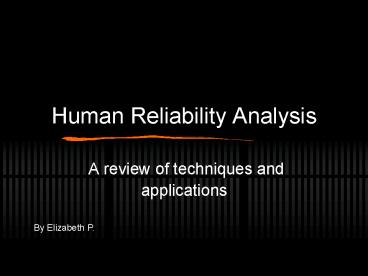Human Reliability Analysis - PowerPoint PPT Presentation
1 / 33
Title:
Human Reliability Analysis
Description:
AGAPE-ET: A methodology for HEA of emergency tasks ... AGAPE-ET it's based on a simplified cognitive model and a set of performance ... – PowerPoint PPT presentation
Number of Views:354
Avg rating:3.0/5.0
Title: Human Reliability Analysis
1
Human Reliability Analysis
- A review of techniques and applications
By Elizabeth P.
2
Outline
- Review of HRA techniques across disciplines
- Differences among the industries and the
techniques required - Benefits and applications
3
List of Acronyms
- HRA- Human Reliability Analysis
- HEP- Human Error Probability
- FTA-Fault Tree Analysis
- ECF- Error Causing Factors
- ELS- Error Likely Situations
- HEI- Human Error Identification
- PIFs- Performance Influencing Factors
- HTA-Hierarchical Task Analysis
4
HRA in Healthcareby Lyons, Vincent, Adams
- The ultimate goal of HRA is to improve
reliability and safety. - Why the scarcity of HRA techniques in the
healthcare system?
5
Differences in Healthcare industry
- Less predictable
- High tolerance for uncertainty
- Industry depends on human-human interaction
- No central focus such as an aircraft or oil
platform
6
Steps in HRA
- 1.-Data collection
- -ethnographic observation
- -questionnaires
- -structured interviews
- -work sampling
7
Steps in HRA
- 2.-Task Description-allows data collected to be
presented in a useful form for error analysis an
quantification - Common approaches
- --Hierarchical task analysis
- --Cognitive task analysis
8
Steps in HRA
- 3.-Task simulation methods
- Theyre build on task descriptions to consider
how the performance of a task might change in
different context under specific circumstances.
9
Steps in HRA
- 4.-Human Error Identification and Analysis
Techniques - FMEA-(Failure Modes Effects Analysis)
- SHERPA-(Systematic Human Error Reduction and
Prediction Approach) - HEART-(Human Error Assessment and Reduction
Technique)
10
Steps in HRA
- 5.- Quantification of Errors- consists of
assigning numbers to uncertain events. - Ex.blood transfusion
- Problem area
- Compound errors
11
Quantification cont
- HEP can be combined using logical OR gates to
provide an estimation of an adverse outcome. - Fault Trees use Boolean logic where probabilities
are assigned to events, these are then inputted
to a gate and they result in the calculation of
the overall probability for the event.
12
Application
- Evaluating risks associated with anesthetist's
performance. - Problems from equipment availability to policy
making can be assessed. - The application of advanced patient monitoring
technology and alarms to identify changes
indicating bleeding or infection.
13
Development and Application of HEI tool for ATC
- By Shorrock and Kirwan
14
TRACEr
- TRACEr- Technique for the retrospective and
predictive analysis of cognitive errors in air
traffic control.
15
Function
- TRACEr was used as a predictive HEI technique for
use with new controller tools, procedures,etc. - It helped to unpack the nature of errors
contributing to incidents in the UK.
16
Structure
- TRACEr is based on a modular structure consisting
of taxonomies. - 3 Main types of taxonomies
- -Those describing the context in which the
error occurred - -Those addressing the production of the
error - -Those describing the recovery of the error
17
Origins
- Need was prompted by a feasibility study for the
use of HRA and HEI techniques in ATC.
18
The Need
- Air traffic was increasing in growth yr by yr.
- That increased the workload for air traffic
controllers - Near- miss incidents were also in the rise.
19
Causes
- Some of the causal factors
- -A variety of controller errors involving
perception, memory,decision making,communication
and team resource management
20
Problem
- Problem with using existing HRA techniques
- -Lack of structure
- -Excessive jargon
- -Excessive resolution
21
Structure
- TRACEr was based on Wicken(92) framework.
- The concepts within the cognitive framework were
named cognitive domains
22
Cognitive Domains
- Perception
- Memory
- Judgment
- Action Execution
23
The cognitive framework
- It was used to organize IEMs (internal error
mode) and PEMs (psychological errror mode) - IEMs are linked to the functions of cognitive
domains.
24
Generation of IEMs with TRACEr
25
Conclusion
- TRACEr technique has been implemented as a
retrospective application such as incidence
analysis technique and as a predictive HEI
technique for use with new controller tools and
procedures.
26
AGAPE-ET A methodology for HEA of emergency tasks
- Human Error Analysis is part of probabilistic
safety assessment. - It estimates HEP(human error probability)
27
AGAPE-ET
- A guidance and procedure for human error analysis
for emergency tasks
28
Function
- Predicts potential weak points related to task
performance - Predicts possible error modes using the
identified contextual information and the
assessment of the possibility of occurrence in a
probabilistic value.
29
Structure
- AGAPE-ET its based on a simplified cognitive
model and a set of performance influencing
factors (PIFs) - 1-First, we identify (ECF) and (ELS)
considering cognitive error mechanisms by
cognitive function - 2-Determine error analysis factors based on
the identification of (ECF) and (ELS). - 3-Make link between (ECF),(ELS) and error
modes.
30
AGAPE-ET Cognitive Model
- Stages
- 1-Detection and activation
- 2-Information gathering
- 3-Situational Assessment
- 4-Planning and Decision making
- 5-Task Execution
31
Example of feed bleed
- Depressurize reactor coolant system by opening
the safety depressurization system while opening
the pressurizer safety valve - Inject coolant into the reactor coolant system
- Check its implementation and effectiveness
32
After thought
- Many times the identification of errors or the
estimation of the probability of their occurrence
seems to be sufficient in the task to reduce
errors. - More work is needed in the prevention aspect of
HRA. - Standarization and validation needed
- More domain specific HRA methods
33
(No Transcript)































